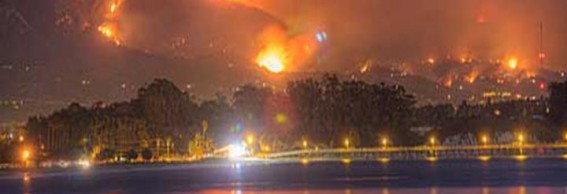November 2008*
The call from our son Daniel—late afternoon on Thursday, about 6:30—was calm, reassuring. He anticipated that we would soon hear about the fires scorching the hilltop chaparral of Montecito, and was eager to report his shelter in the cinder-block gymnasium. The danger, at least then, seemed remote: we talked of homework and soccer matches.
Much of our comfort came from memory. From my own college days at UC Santa Barbara, I recalled that Westmont’s gym was a haven of choice for Montecito evacuees whenever the flames began streaking down the canyons. Those brushfires—the worst in Santa Barbara until now—spared Westmont of all but modest scarring.
But the sundowner winds were crueler this time. After nightfall, spot fires leapt across the campus, devouring older buildings, destroying Daniel’s former dorm, charring trees, and ravaging foliage. So much of what Arlyne—a Westmont alum—and I have loved about the hillside campus proved incendiary: the oil-rich palm and eucalyptus trees cracked like matchsticks, thrusting white embers over rooftops and barrancas, or the dry ravines and creek beds.
When Daniel called the next morning, he spoke of midnight brushfires leaping outside the window of the gym foyer. And of duct tape spread over door cracks and vents, shielding oxygen from smoke. By then, we already knew much about the cost of the night: fifteen faculty homes, including that of his soccer coach. Some of the victims—among them, Paul Willis, English prof and poet—have been longtime friends.
A few weeks back, when I was asked to write something on the Pilgrims for Thanksgiving, I weighed several themes—immigration, religious liberty, and so on—but the fires on my son’s campus certainly alter the ways I think this year about giving thanks. For decades, Gordon and Westmont have enjoyed a special rapport. We share a similar Christian liberal arts vision. Stan Gaede served as our provost and their president. Westmont students come east for a term as Consortium visitors. Many of our own faculty and staff have sent children to study in Montecito. The sorrow of friends lingers into a holiday, even though, from across the country, we sometimes struggle to know what we can do or say. Yet the “Tea Fire” that raced through their campus is a reminder that seasons of gratitude are often tangled with grief.
Thanksgiving, we often forget, is a holiday carved from grief. Usually, though, our national November rhetoric has been an anthem to a plentiful GNP, the presumed imprint of God’s favor. Christmas marketing all but subsumes the day. The morning’s great parade, after all, is sponsored by a department store. More and more, Thanksgiving sanctions neither gratitude nor inspiration but sleep: a high-carb, tryptophan-rich rest before televised football and the Friday-morning discounts.
We seldom recall that Lincoln inaugurated the national day of Thanksgiving in the wake of deaths at Gettysburg and Vicksburg, anxious to retrieve great sadness as a preface to peace. This was a time for the president to commend “to His tender care all those who have become widows, orphans, mourners, or sufferers in the lamentable civil strife.” The Pilgrims’ famous 1621 feast, recast for modern uses, gets told so often as a tale of multicultural and agricultural bounty that we often ignore the sorrowful prologue. The ninety Wampanoag men who brought venison to Governor Bradford for the three-day festivities were survivors from a great Rhode Island tribe decimated by European germs—and fearful of hostile Narragansetts to their west. Bradford recalled the skulls and bones left above ground by Massasoit’s villagers too sick to bury their victims.
The English settlers themselves—some religious dissidents, others fortune-seekers—were only half of the party that disembarked from the Mayflower. Four months of scurvy, dysentery and cold left just a few families intact. Desperately ill, Bradford, a new widower, watched flames spread over the thatched roof of the colony’s one common house, driving the sick shelterless onto the frozen soil. Yet, by summer’s end, with a modest harvest, the survivors found reason to be grateful, despite the fierce price. The Pilgrims, for all of their Calvinism, were more psalmists than prophets, slow to forecast the ways of God, quick to see his mercies in the wilderness.
Thoughts of Puritan trials and Westmont fires almost immediately drew my mind to the verses of Anne Bradstreet, an early settler of Ipswich. Three hundred and forty-two years ago, at some unidentified spot not far from our own campus, the Bradstreets’ servant dropped a candle, igniting the blaze that spread through their dwelling. The flames took it all, including a library of hundreds of volumes. On a “loose leaf” of paper—apparently all she could scrounge up—“Mistress Bradstreet” wrote a string of couplets, entitled simply “Here Follows Some Verses upon the Burning of Our House.” It endures as one of New England’s landmark poems. Early on, she confesses fear—“piteous shrieks of dreadful noise”—before signaling her quick embrace of God’s will.
And, when I could no longer look,
I blest his Name that gave and took,
That layd my goods now in the dust:
Yea so it was, and so 'twas just.
To be honest, I doubt I could muster the will, so quickly, to accept such haphazard destruction as God’s design. Perhaps that’s why I am taken by the transparency of her later lines. Bradstreet embraces her faith without forbidding mourning. She turns toward God, but still surveys the damage, the lost possessions and lost potential:
Here stood that trunk, and there that chest;
There lay the store I counted best;
My pleasant things in ashes lye
And them behold no more shall I . . .
No candle ‘ere shall shine in thee,
Nor bridegroom’s voice ‘ere heard shall be.
In silence ever shalt thou lie . . .
Such emotional candor makes her final assurance—“my hope and treasure lyes above”—even more compelling. I have seen that spiritual resilience in our own faculty. Virtually all of those I know who have lost their lives’ possessions in a fire confess that the losses can be refining. “All things hang lightly on us,” Bruce Herman admitted, after lightning struck his Gloucester land, torching his house and his studio. So few of our belongings, in the end, really matter.
Yet there are still small losses that wound: photos, favorite gifts, rare books, art, and heirlooms. Mourning those losses can be a form of gratitude for the people who brought those things into our lives. I have been drawn to the testimonies of Westmont faculty who remain grateful for God’s care even though they have seen years of mementos—many left by loved ones who have died recently—consumed in the flames. So often items gain new beauty as we become aware just how fragile, scarred and elusive they can be. When Bruce, Jeff Miller and I recently spoke about the Westmont fire, Jeff recounted that the day when his wedding album was returned, years after a fire engulfed his moving van en route to Gordon. Someone has discovered the album—about the only thing that survived the blaze—and sent it back, badly singed, but now distinguished by a smoky patina.
My prayer for Westmont this Thanksgiving is that they would discover dignity and beauty in the smoky patina that now coats their lives. That they would know the benevolence of friends. That the bonds of their community, tightened by crisis, would endure long past the day when new pine needles mask the ashen soil.
And I hope that I can discover, in the fortitude of others, ways of giving thanks in times of grief. Gratitude without blindness to others’ sorrow. Unlike some colleagues at Westmont—and so many persons in the world—I enter this Thanksgiving with a home, without great deprivations. My life is blessed. But each year all of us can count some losses. There will be no Thanksgiving call this month from my father, given his dementia, the scorched neurology of age. But there are plenty of images in my mind of our Thanksgiving leaves, fully raked, only to be scattered by impromptu football games in our family’s backyard. The psalmist would find in such irretrievable moments a glimpse of something eternal, something equally lost and luminous. More and more, I see God’s grace in the architecture of hope and memory.
*First published in Faith + Ideas = (November 25, 2008).


 Essays about Gordon
Essays about Gordon


